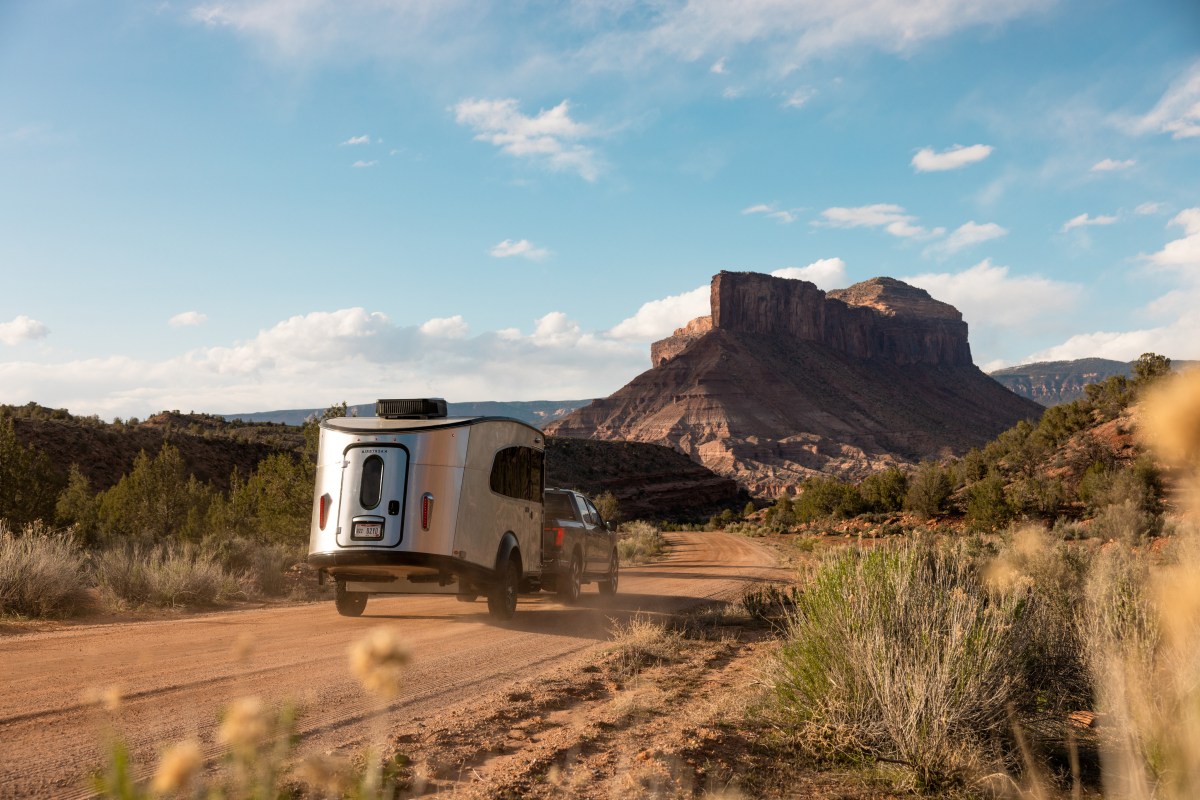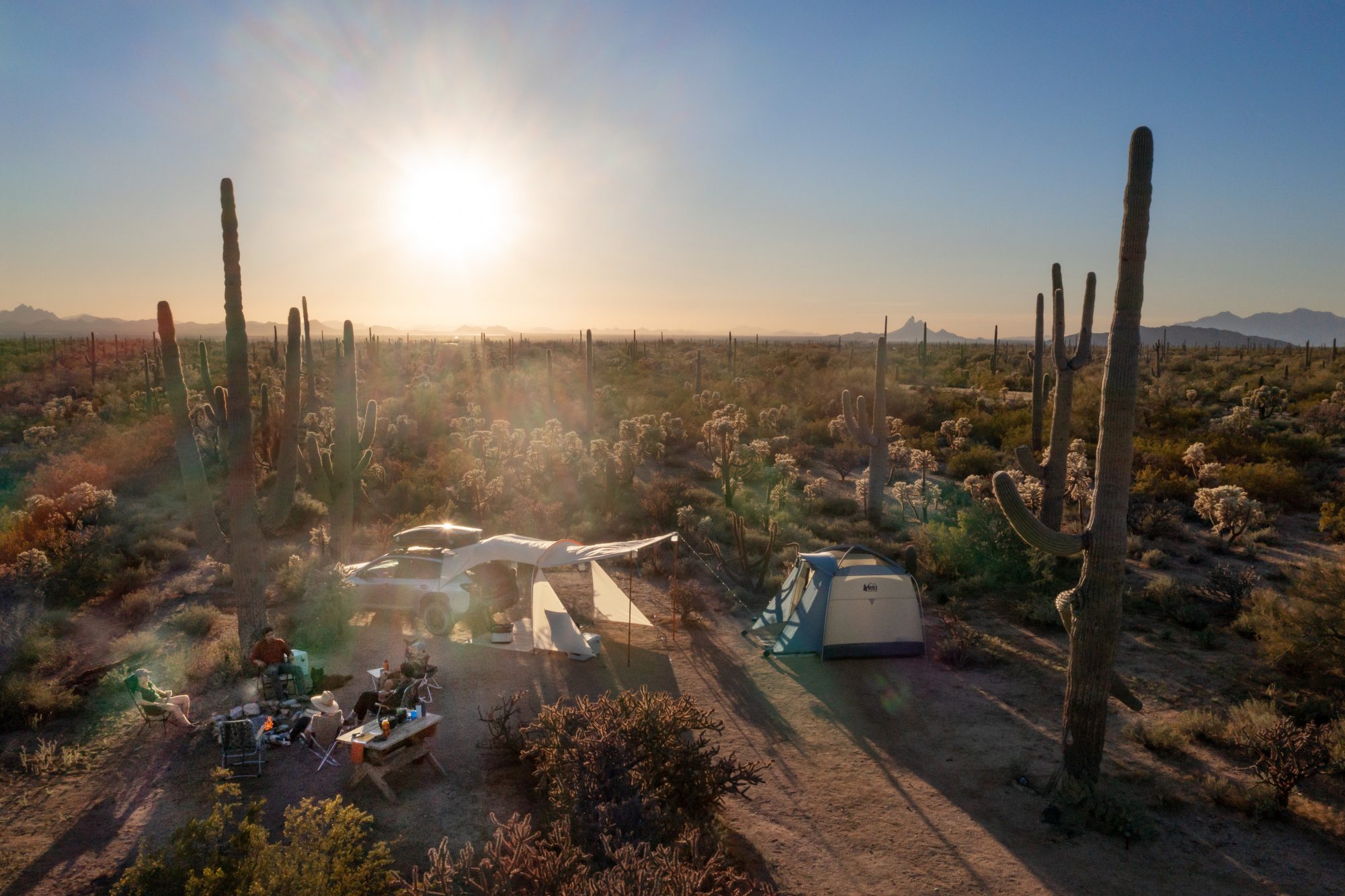I don’t recall exactly what introduced me to the shiny, silver world of Airstreams, but Wally Byam’s caravans to foreign locales intrigued me from an early age. Growing up a “military brat” made me an avid traveler and camper early on, but trailer expeditions were a new world that exuded romance, high adventure and a real sense of bohemian spirit. So, years later when I met and married a man who shared the same penchant for offbeat journeys, we decided to set off on one of our own.
Our on-the-road adventures began in 2017 in our Toyota 4Runner. We spent a month camping out of it while we figured out which kind of RV setup would best suit our needs. The plan was to live in it full-time, so factors like vehicle-towing capacity, trailer length and layout had to be considered. Eventually, we settled on a 25-foot Flying Cloud Airstream.

For two years, we followed our whims, traversing as much of the United States as possible. From lobster rolls in Maine to sopapillas in New Mexico, we experienced every facet, both highs and lows, of an on-the-road lifestyle. Ultimately, a global pandemic, new job and baby changed our course and brought us back to a brick-and-mortar house. Still, we kept the Airstream.
Now our adventures look a little different, but they’re no less fun. Having the trailer and a home has allowed for both the excitement of travel as well a place to return to for a restful recharge. Far-flung destinations still hold their allure, but road tripping the highways and byways of our “backyard” in North Carolina has become invaluable. There’s no doubt that we’ve seen so much more of our home state simply by having our trailer. Backroads we might not have otherwise considered exploring now lead us to new favorite places. Of course, you don’t need a trailer like ours to enjoy this kind of exploration. Adventures come in all shapes and sizes, and I have a few tips to get you started on planning yours.
Tips and Tricks for Vehicle Adventure—Near or Far
The idea of “RV life” often conjures images of long-distance, cross-country road trips, but smaller adventures can be just as epic. We use our trailer every chance we get, for day trips and long weekends, sometimes going no further than an hour away. These shorter, close-to-home journeys are easy and stress-free, and we’ve cultivated tips and tricks to help keep it that way. The following suggestions can be applied to any kind of vehicle-assisted excursion, with or without a trailer, and to all of these I add: simplify, simplify, simplify.

Slow Down
Not only does towing a trailer literally force you to drive slower but, over time, a certain undemanding and unhurried mentality begins to settle in, too. This approach can also apply to people road tripping in smaller vehicles. Unlike other modes of travel, you’re not beholden to timetables or reservations. Tension gets replaced with calm and ease when you know you’re carrying everything you need with you. We’ve come to be more deliberate with our travel, focusing less on what we see than how we see it. Give yourself the freedom and flexibility to follow the unexpected, invite spontaneity, and let go of what a trip should look like. Maybe that means stopping early for the night, taking frequent breaks, or hanging out longer than usual after a lunch break. Ask yourself: What’s the point of checking things off your bucket list if morale has taken a dip?
Keep Your Gear Travel-Ready
Cleaning, maintaining and repairing your rig is of utmost importance, but the work involved can sometimes feel as if it’s stealing precious hours away from the f-u-n. Make a point to address small but necessary tasks after every trip (or even during one) and it’ll save you in the long run. Order parts for your vehicle, clean living spaces (if you have an RV), wash towels and linens, empty and fill your tanks, stay on top of oil changes, make necessary repairs. Do whatever it takes to have your trailer or vehicle ready for the next road trip at the drop of a hat. When Friday rolls around and you’re itching to get out of Dodge, all that’s left to do is pack up and hit the road.
Get Creative
A concrete pad with full hook-ups or a designated spot for parking your car and pitching a tent is great, but don’t limit yourself. Varying your options lends a fresh perspective, and, often, a better feel for the place you’re visiting. We’ve tried everything from roadside rest stops and travel plazas to family campgrounds and boondocking on public land. We’ve spent nights on bustling city streets, too. A quick call to a destination’s tourism office or visitor center might reveal insight on unique places to stay, sometimes at little to no cost. Certain restaurant chains, casinos and retailers allow overnight RV parking, and membership apps like Harvest Hosts have an entire database of wineries, farms and breweries that welcome RVers. Retired and active-duty service members have access to military recreation areas, many of which have options for both RVs or car camping, all over the country. For vehicles without a trailer, apps like Boondocking or AllStays can help with the search. And in our state of North Carolina, the Department of Transportation permits any highway-legal trailer (in addition to passenger vehicles) to ride aboard their network of ferries. Bottom line: If something peaks your interest, go check it out.
Plan for Fun, but Pack for Contingencies
Travel with the understanding that the unpredictable will happen. Inclement weather, traffic or injuries and illness can sneak up on you quickly. Some items—like first-aid kits, blankets and tools—never leave our vehicles. For longer trips, we’ll throw in additional necessities like drinks, healthy snacks and packed lunches, charging cords, downloaded maps, headlamps and cash. And for more extensive trips, particularly out West, extra fuel and water is hugely important given that there may be long stretches without opportunities to replenish. (For more ideas on what to bring, check out this car-camping checklist.) The same goes for hikes. We never leave camp without a pack. Here’s a pro tip I love, especially if you’re exploring alone: Record details of your outing in your cell phone’s voicemail greeting. Even if your battery dies, friends and family will have information on your whereabouts if they try to contact you.
What’s in My Vehicle
The “less is more” principle works best for us, but we do have several indispensable favorites that we love to bring along. There’s a certain satisfaction and enjoyment in “roughing it,” but sometimes a situation calls for efficiency, convenience or a touch of creature comfort. The five pieces of gear on this list can help improve any camping experience.

Camp Chairs
One of the best feelings after a big day outdoors is settling in to grab a seat beside the fire. It’s a satisfying reward and a chance to put up your feet, relax and take in the view. We love our Flexlite camp chairs by REI Co–op for their portability and durability. This particular style, with legs that fold like tent poles, is simple to set up and takes up less space compared to more traditional chairs. They fit easily into a storage compartment, trunk or backpack.
Gear Up Like Amy: A camp chair with a headrest? You betcha. The Flexlite Camp Dreamer, one of several Flexlite styles, has a supportive high back, a removable pillow, roomy pockets and four legs to provide stability. It holds up to 300 pounds and folds down to about the length of three Nalgene bottles. $99.95 Buy here.
A Pressure Shower
The NEMO Helio Pressure Shower is, hands down, one of the most functional and essential pieces you can take with you if pets and kids are part of your adventures. The handy spray nozzle keeps wasted water to a minimum, and even the smaller size (it comes in 11 and 22-liter versions) holds more than enough water to rinse sandy feet, clean cookware or wash off a muddy dog. With such a streamlined design, it can be tucked into a corner of our truck bed, hassle-free, for grab-and-go access.
Portable Jump Starter
Whoever invented this should get a medal. You don’t realize how valuable a portable jump starter is until you really need it. In our case, that moment arose in the middle of a remote desert, the summer of 2017, miles from anything. Unbeknownst to us, an interior light had been on for hours and drained our vehicle’s battery. Thankfully, we had packed our starter and were back in business within a matter of minutes. It saved the day and prevented what would have been a very long hike into town.
Portable Propane Stove
If we’re strictly car camping, we use a deep, single burner cooking system to prepare the bulk of our food and coffee. We use the Coleman 4-in-1 Portable Propane Stove and we like that it comes with a wok and a reversible grill/griddle, which means that breakfast, lunch and dinner can all be made on one stove. It’s small and compact, and cleanup is quick. The propane canisters are easy to find and they eliminate the need to carry lighter fluid or charcoal.
Gear Up Like Amy: Whether you want morning pancakes or a burger for dinner, you can whip it up on the Coleman Cascade 3-in-1 Stove. This two-burner stove also comes with a removable griddle and grill, providing flexibility to please a variety of hungry campers. Plus, this stove includes two guards that help shield your flame from the wind on blustery days. $210 Buy here.
Analog Entertainment
When the weather turns nasty, you’re tired or you’re in the mood for lounging around camp, it’s nice to have something on hand that doesn’t require a power source or Wi-Fi network. Digital devices have their use, but “unplugged hobbies” can be enjoyed anywhere, at any time. I keep a sketchbook and pens to document a day’s events or jot down notes, but paperbacks, crossword puzzles, a ukulele or chess board have made the cut, too.
